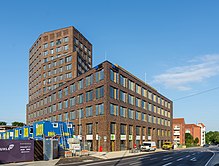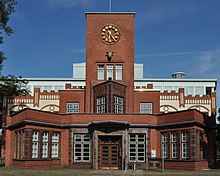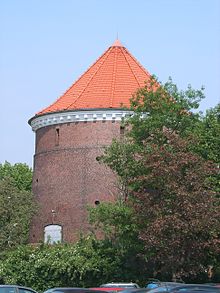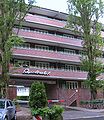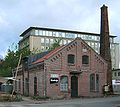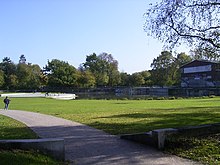Hamburg-Barmbek-Nord
|
Barmbek-Nord district of Hamburg |
|
|---|---|
| Coordinates | 53 ° 36 '19 " N , 10 ° 2' 24" E |
| surface | 3.9 km² |
| Residents | 41,875 (Dec 31, 2019) |
| Population density | 10,737 inhabitants / km² |
| Post Code | 22049, 22297, 22303, 22305, 22307, 22309 |
| prefix | 040 |
| district | Hamburg North |
| Transport links | |
| Train |
|
| Subway |
|
| Source: Statistical Office for Hamburg and Schleswig-Holstein | |
Barmbek-Nord is a district in the Hamburg-Nord district of the Free and Hanseatic City of Hamburg . Until 1951 he formed the district of Barmbek together with Barmbek-Süd and Dulsberg .
geography
Geographical location
Barmbek-Nord is located in the east of the Hamburg district of Hamburg-Nord. Hamburg city center is about five kilometers away. Barmbek-Nord is part of the inner city of Hamburg, understood as a coherent, continuously built-up area around the Hamburg city center .
Neighboring districts
Clockwise (starting from the north), Barmbek-Nord borders the Hamburg districts of Ohlsdorf , Steilshoop , Bramfeld , Wandsbek , Dulsberg , Barmbek-Süd and Winterhude .
After Winterhude, the village boundary was first agreed between the farmers of both villages in 1726. At that time it ran in the eastern part of today's city park . With the construction of the railway line from Barmbek to Ohlsdorf at the beginning of the 20th century, this became the district boundary in the north, while Saarlandstraße now forms the border south of Hellbrookstraße. The borders to Alsterdorf, Steilshoop and Bramfeld were set in 1773, whereby a small piece of the Alsterdorf district fell to Barmbek in the course of the hospital construction .
history
In the largely unpopulated area, the Barmbeck farmers had their fields. Due to legal disputes about the 5th Hufe, the coupling that began in the 1760s was not fully completed, so that, in addition to the two gullies on the Alte Wöhr, only on the "Olen Enn" (the former border to the submerged village of Hartzloh, to which the street of the same name reminded), the Heidhörn and parts of Rübenkamp's assignments took place. Later on, individual farmers achieved more productive arable land for their farms through internal land swaps, for example in the south-west of Langenfort, on the Stellberg terrain and, in the 19th century, in the northern Feldmark as well. From 1784, large parts of the common pasture were distributed to the Vollhufner and the Kätner , now called Halbhufner . Care was taken to ensure that sufficiently large pieces were created so that every farmer could create a large cow pasture. Most of the pastures arose outside of today's Barmbek-Nord. But also south of Alten Wöhr (10th Hufe), on Bramfelder Straße on the site of today's shipbuilding research institute (2nd Hufe) or Techniker Krankenkasse (11th Hufe) and later on Habichtstraße, where the Köster Foundation is today is located, (12th hooves) pastures were created.

Around 1800 farmers in Barmbeck - Hufner as well as Kätner - increasingly began to sell individual areas to third parties, partly as residential properties, partly for commercial purposes. Around 1870, the owners of Hufen 6, 7 and 11 sold areas north of the Osterbek to Johann Hinrich Wilhelm Maurien, who founded the New York Hamburger Gummi-Waaren Compagnie with business partners and later bought additional properties to expand the business. In 1897 the city acquired 3.58 hectares of the 9th Hufe on Steilshooper Straße to build a masking shop.
Until the neighboring villages of Bramfeld and Steilshoop were incorporated by the Greater Hamburg Law in 1937 , today's districts of Barmbek-Nord and Dulsberg, which at that time were still known as Barmbeck -Süd together with Barmbek-Süd , formed part of Hamburg's eastern border with Prussia . But the Osterbek also formed a border: Since Hamburg had not initially joined the German Customs Union , Barmbek-Süd belonged to the Hamburg customs inland, Barmbek-Nord to the Prussian customs area. In order to avoid double customs formalities, the aforementioned Gummi-Waaren Compagnie settled here.
In 1840, Johann Hinrich Harckensee was the first hoof to move the fourth hoof from the village center to the north of Barmbeker at Bramfelder Strasse 43, roughly where the DRK rescue station is today. He was followed in 1890 by Heinrich Dreckmann, who moved his farm, the 12th Hufe, from the old village square to the border to Bramfeld, where he built the "Habichtshof" north of the Habichtstrasse on the Hellbrookweiden, which - mutilated by destruction in the Second World War - still up to 2008 stood there. As early as 1883, when Heinrich's father Jochim Hinrich Dreckmann was still running the farm in the center of the village, Heinrich Dreckmann had built a garden house on the Hellbrookweiden in which he lived with his wife and, from 1884, the first-born son Hans Dreckmann . The Habichtstrasse, previously called path no. 207 and paved since 1878 , was later named after the Habichthof . The rare case of a new farm was founded in 1891, when Johann Jochim Lembcke's heirs gave a good 19 hectares of the 10th Hufe in the eastern Feldmark to his second son Adolph, who set up a new farm at Bramfelder Straße 86.
Since the turn of the 20th century, most of the farmers in Barmbek-Nord gave up farming or continued to farm outside of Barmbek in more rural areas in front of the city. The Aerar of the Free and Hanseatic City of Hamburg acquired the full hoof rights of eleven of the twelve hooves as well as a large part of their remaining lands. The only remaining farm, the 12th Hufe, which was then managed by Heinrich Dreckmann, was given a plot of land on what is now Emil-Janßen-Straße as compensation for the loss of common pasture use. When the construction of the Hamburg warehouse district in 1883 required the demolition of a large working-class district, the northeastern Feldmark was developed and settled in order to create new living space. In 1907 the Hamburg-Altona city and suburban railway started operating with the Barmbeck station. At the same time, the construction of the Hamburger Hochbahn began , which went into operation in 1912.
In 1910, the Barmbek hospital , located in a forest at the northern end of the district, on the border with Alsterdorf , opened , the grounds of which were designed as a park. The Rübenkamp stop was created for the visitors . In 1931 the Alte Wöhr stop was added.
The importance of Barmbek for urban change in the course of industrialization is enormous. As a pioneering location for urban planning in the 1910s and 1920s in the " New Objectivity " style, Barmbek-Nord is an urban cultural monument of international standing. Several thousand apartments were built in the second half of the Weimar Republic . Commercial enterprises were only approved as shops and service providers directly required to supply the residents. As the last farmer in Barmbek-Nord, Heinrich Lembcke, who had his fields in the then still Prussian Steilshoop , gave up farming in 1923; the Barmbek full-horse rights of the 10th hooves had already passed to the city in 1900. His yard with the farmhouse on Hufnerstrasse, built in 1623, fell victim to the Allied bombing raids on the night of July 29th to 30th, 1943. One year before Lembcke, Heinrich Dreckmann - worn down by the plundering of fields after the First World War - was the last full- horse to give up farming in Barmbek. Dreckmann's children built rental apartments on the associated land, which were managed by Arnold Dreckmann. Overall, 93% of the apartments were completely destroyed (77.8%) or at least severely damaged (15.2%) in the area of today's district. In contrast to Barmbek-Süd, the district was rebuilt conceptually unchanged after the Second World War - apart from simplifications of the facade and changes to the ground plan in individual cases. Exceptions are the Hochbahnschleife area and the new buildings around Drossel- and Starstraße. In 1956, the reconstruction of the district was largely complete.
Religions
Since the introduction of the Reformation by Johannes Bugenhagen , Hamburg has been shaped by Lutherans. Even today, the Evangelical Lutheran Church is still the strongest religious community in Barmbek-Nord, even if the majority of the residents are now non-denominational.
The first parish church built in Barmbek-Nord is the Resurrection Church in Tieloh, which was built from 1916 to 1920 according to plans by Camillo Günther . Before that, the area had belonged since 1903 to the parish of the Heiligengeistkirche in Barmbek-Süd, which was responsible for all of Barmbek and Dulsberg. After the Second World War, the St. Gabriel Church on Hartzlohplatz was added on the northern edge of the district and St. Bonifatius Church on Lämmersieth in the east of the district. In addition to these three Evangelical Lutheran parishes, there is the Roman Catholic St. Franziskus Church in Lämmersieth, which was built in the 1920s and whose parish area also includes the Dulsberg. There is also a New Apostolic Church on Schwalbenstrasse and a Protestant free church on Fuhlsbüttler Strasse, the Christ Congregation Barmbek-Nord, which is part of the Mülheimer Verband .
Population development
For the numbers before 1951 see the article Barmbek . In 1939, when Barmbek was not yet divided into three districts, the area of today's district had 71,826 inhabitants. The source for the figures up to 1984 is the work of Bernhard Beyerlein. More recent figures come from the statistical office for Hamburg and Schleswig-Holstein .
- 1950: 37,404
- 1961: 64.391
- 1970: 51.720
- 1980: 41.107
- 1984: 39.023
- 2016: 41,475
statistics
- Minor quota: 10.1% [Hamburg average: 16.3% (2017)].
- Old age quota: 13.1% [Hamburg average: 18.2% (2017)].
- Proportion of foreigners: 13.3% [Hamburg average: 17.1% (2017)].
- Unemployment rate: 5.0% [Hamburg average: 5.2% (2017)].
The average income per taxpayer in Barmbek-Nord is EUR 28,330 annually (2013), the Hamburg average is EUR 39,054.
politics
For the election to Hamburg citizenship , Barmbek-Nord belongs to the constituency of Barmbek-Uhlenhorst-Dulsberg , for elections to the Hamburg-Nord district assembly to constituency 6 (Barmbek-Nord) and for federal elections to constituency 18 (Hamburg-Mitte) . The 2015 state election brought the following results:
- SPD : 46.0% (-5.7)
- Greens : 15.1% (+0.4)
- Left : 11.9% (+3.3)
- CDU : 10.0% (−3.7)
- AfD : 5.5% (+5.5)
- FDP : 4.9% (+1.0)
- Others: 6.6% (-0.8)
Urban development
Around the Fuhlsbüttler Strasse shopping street and the Barmbek U / S and bus station , the Barmbek-Nord district was declared a redevelopment area by the Senate in July 2005 . Preliminary investigations had shown that the southern part of Fuhlsbüttler Strasse offers potential for urban redesign.
This includes the intended establishment of a new area for the weekly market. The efforts were pushed by the Bürgerhaus Barmbek and the Resurrection Church in Barmbek . Starting with the wish tree campaign, the organizations asked the Barmbeker what should be improved in the district. The district discussion has been held at regular intervals since the campaign began.
The Barmbek train station has been under construction since 2009. The bus station originally north of the tracks from the 1960s was abandoned in 2011 and replaced by bus stops directly at the station in the streets Wiesendamm and Krüsistraße. After years of construction delays by Deutsche Bahn, the work in the station itself is still going on in the S-Bahn section. In the subway section, they are largely completed.
A 15-storey office building has been erected on the area of the former bus station at Barmbek train station, in which the headquarters of the administrative trade association (previously at Deelbögenkamp in Alsterdorf ) has been based since 2016 . The department store directly to the east was demolished after a long vacancy due to the insolvency of the Hertie chain. A new commercial building with retail, catering and office space is being built here, with a hotel on the upper floors as the entrance to Fuhlsbüttler Straße. This street was redesigned in 2015 and was given more space for pedestrians and cyclists in particular. Adjacent individual low-rise buildings from the post-war period are to be replaced by higher buildings. Vacant lots in the area, for example along Drosselstrasse , are intended to be closed in order to use the areas in particular for residential construction.
On the eastern edge of the district, east of Steilshooper Straße, an extensive new building area with around 700 apartments is planned. Here, the area is being comprehensively reorganized, particularly with regard to commercial, sports and allotment areas.
Immediately behind the western border of Barmbek, between the S-Bahn line and the city park, further large-scale construction projects are planned on allotment gardens, the area of the former Barmbek freight station has already been built on with apartments. These areas are already in Winterhude.
Culture and sights
Museums
The Museum of Work was established in 1998 in the former New York Hamburger Gummi-Waaren Compagnie on Maurienstraße. It mainly shows how work has changed over the past 150 years. The focus is on excerpts from the areas of the working world that are typical for Hamburg (printing or fish industry, office and port work). With great support from its sponsoring association, the museum offers courses to learn old working techniques such as goldsmithing or printing. The cutting wheel of the Elbe tunnel drill TRUDE ( T ief R under U nter D ie E lbe), with which the fourth Elbe tunnel tube was drilled, has found its new home in the courtyard of the museum .
Buildings

Buildings from the time before the First World War hardly exist in Barmbek-Nord today. On the one hand, the large-scale development before 1890 had only progressed to today's Hellbrookstrasse, on the other hand, much was destroyed in the Second World War. Individual old buildings have also been preserved in Fuhlsbüttler Strasse and Steilshooper Strasse. Examples of both preservation and destruction are the single-storey rows of houses in Bramfelder Strasse 100 to 108 designed by Heinrich Dreckmann from 1901 to 1903 , in front of which front houses were placed a few years later, so that the typical Hamburg residential terraces were created. Only the two front buildings, Bramfelder Strasse 106 and 108, remain of this development. A forge was set up in the front building at number 108. Today there is a plumbing shop there.
Today, Barmbek-Nord is predominantly characterized by brick architecture. The range of design and quality is quite large. Well-known architects such as Karl Schneider and Friedrich Richard Ostermeyer have also designed residential buildings for this part of the city, which is becoming increasingly popular among the working class thanks to the fast transport links provided by the subway. Ostermeyer created the Adolf-von-Elm-Hof on Fuhlsbüttler Strasse, next to the block on Bendixensweg, one of the early examples of New Building .
Fritz Schumacher designed several school buildings and the police station on Hartzlohplatz for the district.
The redesign of the former rubber hard goods factory into a museum of work has led to a revitalization of the southern station area of the S-Bahn and U-Bahn station Barmbek . The municipal housing company SAGA in Hamburg and the GWG restored parts of the factory and set up their head offices in the courtyard of the museum on the Osterbek Canal .
In the immediate vicinity of the Museum of Labor, opposite the southern exit of the train station, there is a round bunker from the Second World War. The "Zombeck" type bunker was built in 1939 and has been a listed building since 2003.
On the corner of Habichtstrasse / Bramfelder Strasse is the listed entrance area of the former Voss margarine factory designed by Henry Grell and Peter Pruter - the Voss factory in every house - which is now part of the headquarters of the Techniker Krankenkasse . The beef head and the two employee figures to the left and right of the entrance door symbolized the great importance of margarine production for supplying the population with inexpensive edible fats. The architecturally interesting headquarters of the Techniker Krankenkasse was built on the former factory site from 1985 to 1989 according to plans by Heinz Graaf and Peter P. Schweger .
In the north of the district is the area of the former General Hospital Barmbek. After the Asklepios Klinik Barmbek was rebuilt on the northern part of the site , Quartier 21 was created on the southern part . Some of the old pavilion houses of the hospital opened in 1913 were converted into living space, and some new construction projects were also implemented, such as the Hochtief house on Fuhlsbüttler Strasse, in which the construction company merged its Hamburg branches in spring 2012. The Hamburg-Barmbek water tower is a striking structure , which has been revitalized and contains various uses, including a restaurant and a fitness studio.
Block of flats designed by Karl Schneider for the non-profit housing association Groß-Hamburg
The Schwalbenhof of Paul Frank
The tin melt
Parks and green spaces
The former turning basin of the Hamburg Shipbuilding Research Institute was converted into a green area in 2004. In previous years there had been a political dispute over a trailer colony located there. While the FDP and GAL had spoken out in favor of the construction trailer residents staying, the SPD (in order to create the parking facility they had promised), CDU and the Rule of Law Party (both out of fundamental opposition to construction trailer spaces) demanded an eviction after the contract expired in 2004 and were able to - supported by a referendum - thus also enforce.
Sports
The most famous sports clubs in Barmbek-Nord are the HSV Barmbek-Uhlenhorst , briefly called BU and the SC Urania Hamburg , as well as the Barmbek strength sports club Goliath . The BU footballers even played in the second Bundesliga in the 1974/75 season . Urania is particularly successful in table tennis , the first women's team in this sport played for many years in the Regionalliga Nord. Both clubs also offer almost all other common sports.
There are also a few smaller sports clubs in the district that are limited to individual branches. The Hamburger Turngesellschaft Barmbeck-Uhlenhorst e. V. from 1876 , which is actually based in the Barmbek-Süd district .
The BKSV Goliath is the oldest sports club in Barmbek . It has existed since 1903. At the beginning of the 20th century, weightlifting, stone throwing, wrestling and lawn power sports were in the foreground. Today the club is mainly dedicated to the martial arts. Aikido , Judo , TaiChi and Qigong , Bartitsu , self-defense and fencing can be learned and actively practiced there.
Other leisure activities
There is a scout home in the former youth house on Wittenkamp. The Association of Christian Scouts, tribe Astrid Lindgren, is located in the parish hall of the Church of the Resurrection in Tieloh.
Economy and Infrastructure
economy
Until well into the 19th century, Barmbek was a typical farming village with a corresponding economic structure, although in the barely populated north of Barmbek there were almost exclusively fields and meadows for agricultural purposes.
Mills
In the 19th century a windmill was built in the area of today's Barmbek train station , which also fell victim to the fire in 1888 and was then rebuilt as a steam mill in Barmbek-Nord (there is now a specialist shop for roof and facade supplies).
traffic
The district is crossed from south to north by Bramfelder Straße , part of the old trade route that leads north from Hamburg via Mundsburg and Barmbek and finally reaches Lübeck via Bergstedt , Bargteheide and Bad Oldesloe . Until 2005 it was part of the federal highway 434 and today it is still the main thoroughfare of the district. From Bramfelder Strasse, Steilshooper Strasse and Fuhlsbütteler Strasse, directly north of Osterbek, are two streets in a fan shape to the northwest, which not only connect Barmbek-Nord with the two eponymous districts, but are also the main access routes for the residential areas. To the north of the Barmbek train station, the Krausestrasse / Drosselstrasse / Rübenkamp road from the east crosses another important access road, Bramfelder Strasse. The north of the district cuts the district from Winterhude to Dulsberg with Ring 2 (street Lauensteinstrasse / Barmbeker-Ring-Brücke / Habichtstrasse ), the middle of the three Hamburg road half-rings .
The center of the public transport -Angebots in the district is the Barmbek station , which of the U-web - line 3 , the train is operated-lines 1 and 11, and many bus lines. The Rübenkamp and Alte Wöhr S-Bahn stops and the Habichtstraße underground station are also in the district. The Saarlandstrasse and Alter Teichweg underground stations are located directly behind the borders with the neighboring districts of Winterhude and Dulsberg.
The Rübenkamp station building , built in 1913 according to plans by Ernst Schmidt, was replaced by the Verein Unser Bahnhof e. V. acquired and restored.
Established businesses
Barmbek-Nord is the headquarters of several large companies. These include the headquarters of Techniker Krankenkasse on Bramfelder Strasse / Habichtstrasse and the headquarters of Hamburg's largest housing company SAGA on Osterbek Canal. The main administration of the professional association is located directly at the Barmbeck train station in a high-rise that was built until 2016 .
education
Barmbek-Nord is well developed as a school location. With the Margaretha-Rothe-Gymnasium , the district schools Helmuth Hübener (in Benzenbergweg) and Emil-Krause-Schule (with the locations Tieloh and the Emil-Krause-Oberstufe in neighboring Dulsberg) and the primary schools Genslerstraße and Lämmersieth , all types of schools are represented in the district . In addition to these state schools, there is also a Roman Catholic district school with the Franz-von-Assisi-Schule am Lämmersieth and a private school in the district with the Alsterring-Gymnasium in Wittenkamp.
Personalities
- Max Weiss (1884–1954), painter and lithographer, lived in Barmbek-Nord.
- Alfred Johann Levy (1901–1987), Member of Parliament ( FDP )
- Tom Hops (1906–1976), painter and graphic artist, lived in Barmbek-Nord.
- Helmut Schmidt (1918–2015), Federal Chancellor ( SPD )
- Ralph Giordano (1923–2014), journalist and writer
- Angela Merkel (born July 17, 1954), Federal Chancellor ( CDU )
- Andreas Brehme (born November 9, 1960), soccer player and coach
- Gerrit Heesemann (born February 4, 1967), alias singer "Lotto King Karl"
See also
- List of streets, squares and bridges in Hamburg-Barmbek-Nord
- List of cultural monuments in Hamburg-Barmbek-Nord
- List of stumbling blocks in Hamburg-Barmbek-Nord
literature
- Timon Hoppe, Stefan Brauckmann: North Barmbeck - Barmbek-North. Analysis of a central quarter in the current structural change. Norderstedt 2009. ISBN 3-8370-9954-7
- Barmbek history workshop: Ten days in July - survival under the bombing raids Barmbek 1943, Hamburg 1994
Web links
Individual evidence
- ↑ Hans Dreckmann : From the limits. In: Hans Dreckmann, Henny Wiepking, Walter Lüdemann: Barmbek. From the village to the big city. A home book. Dammtor-Verlag, Hamburg 1965, page 18 ff.
- ↑ Hans Dreckmann: The coupling. In: Hans Dreckmann, Henny Wiepking, Walter Lüdemann: Barmbek. From the village to the big city. A home book. Dammtor-Verlag, Hamburg 1965, page 34 f.
- ↑ a b Hans Dreckmann: Division of the common pasture. In: Hans Dreckmann, Henny Wiepking, Walter Lüdemann: Barmbek. From the village to the big city. A home book. Dammtor-Verlag, Hamburg 1965, page 38.
- ↑ a b c The owners of the Barmbeker farms and the whereabouts of the Hufenland. In: Hans Dreckmann, Henny Wiepking, Walter Lüdemann: Barmbek. From the village to the big city. A home book. Dammtor-Verlag, Hamburg 1965, pages 39 ff.
- ↑ Johann Delekta: Habichthof - A pearl in the crown of dirt's family. In: The Barmbeker. Bulletin for Barmbek, North District and Hamburg. Issue 9/2010, page 14 ff.
- ↑ Timon Hoppe, Stefan Brauckmann: North Barmbeck - Barmbek-North. Analysis of a central quarter in the current structural change. Norderstedt 2009. ISBN 3-8370-9954-7 , p. 193
- ^ A b c Bernhard Beyerlein, district analysis . A guide to exploring neighborhoods . Society for Sociological Urban Research, Hamburg 1986
- ↑ Von Barmbeker peasant families - a visit to Hinrich Lembcke of twenty years. In: Der Barmbeker, magazine of the Barmbek citizens' association from 1859 r. V. issue October 1956.
- ^ A b Dieter Thiele: Life on the Habichthof - a Barmbeck farming family between town and country 1890-1914. Edited by the Barmbek history workshop, Hamburg 2005.
- ↑ Quota of minors in the Hamburg districts in 2017
- ↑ Proportion of 65-year-olds and older in the Hamburg districts in 2017
- ↑ Proportion of foreigners in the Hamburg districts in 2017
- ↑ Unemployment rate in the Hamburg districts in 2017
- ↑ Statistical Office for Hamburg and Schleswig-Holstein (ed.): Hamburg District Profile 2016 (= NORD.regional . Volume 19 ). 2018, ISSN 1863-9518 ( Online PDF 6.6 MB [accessed February 12, 2018]).
- ↑ http://www.wahlen-hamburg.de/wahlen.php?site=left/gebiete&wahltyp=3#index.php?site=right/result&wahl=973&gebiet=7&typ=4&stimme=1&gID=5&gTyp=2
- ↑ Hans Dreckmann: The individual properties before 1830. In: Hans Dreckmann, Henny Wiepking, Walter Lüdemann: Barmbek. From the village to the big city. A home book. Dammtor-Verlag, Hamburg 1965, pages 86 ff.
- ↑ List of monuments of the Free and Hanseatic City of Hamburg, as of April 13, 2010 (PDF; 915 kB) ( Memento from June 27, 2011 in the Internet Archive ) (PDF; 915 kB), as of March 23, 2009, Monument Protection Office in the Authority for Culture, Sport and Media, p. 209, list of monuments no. 1368. Position: 53 ° 35 ′ 11.6 " N , 10 ° 2 ′ 41.6" E
- ^ Hermann Hipp : Free and Hanseatic City of Hamburg, History, Culture and Urban Architecture on the Elbe and Alster. DuMont Buchverlag, Cologne 1990, p. 444, ISBN 3-7701-1590-2 .
- ↑ Information on Quartier 21 on the Hamburg-Nord district website. Retrieved February 19, 2016.
- ^ Hans Dreckmann: Mills in Barmbek. In: Hans Dreckmann, Henny Wiepking, Walter Lüdemann: Barmbek. From the village to the big city. A home book. Dammtor-Verlag, Hamburg 1965, page 16 f.
- ↑ Gustav Bolland : The Bramfelder Bridge in Barmbek. In: Hamburgische Geschichts- und Heimatblätter, year 1970, issue 8, pages 217–227.
- ^ Almut Nitzsche: Angela Merkel. In: FemBio. FemBio Women's Biography Research e. V., January 2007, accessed on July 11, 2010 .








